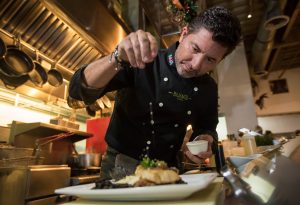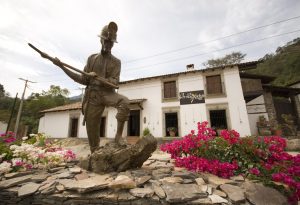Our Food Diaries series takes a deep dive into Mexican culinary cornerstones. In each article, we’ll be uncovering key ingredients that tell the fascinating stories of Mexico’s multilayered identity, bridging the gap between ancient and contemporary life.
POV: You´re in Jalisco state, on the open road driving west from Guadalajara with your private guide. Below a clear cerulean sky, undulating fields roll out as far as the eye can see, tracing the landscape’s dips and peaks. As you get closer, you can make out uniform rows of spiky figures, with mighty petrol-blue leaves that defy gravity as they reach towards the sun.
This is a place intricately shaped by agave culture, with UNESCO’s stamp of approval thanks to its pivotal role in the production and international growth of Mexico’s most legendary spirit. The town of Tequila and the surrounding region are a testament to artisan tradition, innovation and generational pride, blending natural beauty with Mexico’s biodiversity and rich heritage.
In this first chapter of Food Diaries, we welcome you to the wonderful world of agave! Through centuries of cultivation and craftsmanship, agave has evolved into more than just a plant; it stands as a symbol of Mexican identity, resilience, and ingenuity. Join us to uncover the meaning of this magnificent plant in Mexican culture, from ancient folklore to acts of resistance and family legacy.
Plant Anatomy
There are over 200 types of agave worldwide and Mexico is the guardian of a whopping 70% of endemic species. You might also hear the name ‘maguey’ thrown around, a traditional collective term for specific types of agave, especially those used to make mezcal like espadín and wild varieties such as madre cuixe and tepeztate, and pulque, produced from agave salmiana, also known as maguey pulquero. The plants come in all shapes, sizes and colors, but only one variety, ´blue agave´ (tequilana weber) can be used to produce Mexico’s most famous spirit, you guessed it – tequila!
Agave plants are a spectacle to behold, with sturdy leaves arranged in rosettes that narrow to a sharp point. Just before the end of its life cycle, a monumental stem shoots up to great heights from the agave’s heart, yielding sap and edible flowers for the first and final time. Each agave plant takes between 8 to 25 years to mature and can only be harvested once – a fact that makes us value each sip of tequila that little bit more.
The core of the plant holds the key to producing agave distillates – named the ´piña´ after its resemblance to a huge pineapple – and is harvested by highly skilled farmers. These ´jimadores´ know exactly how and when to cut off the hardy leaves with a long and heavy flat-bladed knife called a `coas` – no easy feat!
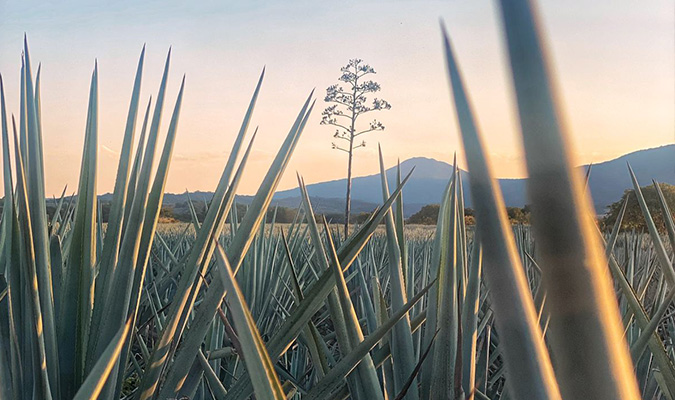
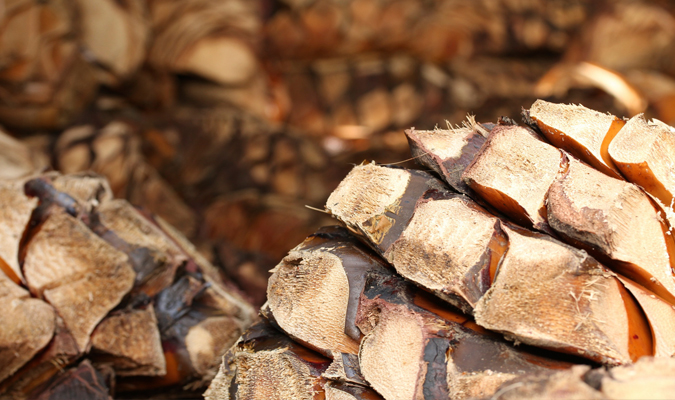
The Beginning: Ancient Aztec Rabbit Gods & Pulque
Agave culture in Mexico goes way back – we’re talking over 3,000 years ago. In pre-Hispanic times, the plant’s value weaved through the fabric of daily life; used to make rope and textiles (with thorns as sewing needles), for its nutritional value, to treat gut issues, as a nutritional supplement, and even as a sedative in ritualistic sacrifices. Cultures, including the Olmecs and Aztecs, were the first to ferment sap called ´aguamiel´ (honey water) from the plant’s stem to create ‘pulque’, a milky-colored, low alcohol beverage with a tart taste and a thick, bubbly, viscous consistency.
Maguey has deep roots in ancient indigenous spirituality and was revered as a sacred plant. The Aztec Goddess, Mayahuel, was depicted as the guardian of agave, symbolizing health and nourishment, abundance, fertility, and connection to the divine. In Aztec belief, Mayahuel and the God of Pulque, Tepoztēcatl, bore 400 rabbit children, Centzon Totochtin, who were the Gods of Drunkeness. As pulque has the power to intoxicate and grant access to other realms, it was seen as something otherworldly, and the Totochtin represented the different ways in which the Aztecs could manifest inebriation. The character of a person would influence which rabbit they would become, from drunken expressions of dancing, singing, and shouting, to crying, blurred vision, and even getting tattooed.
Pulque can be seen as a symbol of rebellion, with a story that goes hand in hand with Mexico’s history. It’s nickname, ‘drink of the Gods’, takes us back to pulque’s sacred beginnings as a libation reserved for deities, priests, warriors, and emperors. After the downfall of the Aztec empire at the hands of Spanish conquistadores, pulque became widely produced around Mexico’s central highlands and found its place as both a drink of the people as well as one of the area’s important economic drivers. During the reign of the Spanish crown in the colonial period, pulque was banned on the grounds of ties to non-Christian religions. Even as production went underground, its economic power could not be ignored, and prohibition was eventually lifted at the end of the 18th century.
Pulque’s popularity amongst the masses continued throughout Mexico’s War of Independence and freedom from the Spanish Empire. The only reason the drink’s prominence fell was due to a marketing campaign following government-sanctioned foreign investment, which included breweries, that degraded pulque as unhygienic and ´low-class´ in a bid to increase demand for beer. Still, the beloved beverage resisted adversity just as it defied colonial oppression, making it an icon of cultural authenticity and resilience. In modern-day Mexico, pulque is having somewhat of a revival. Pulquería bars, traditional in Mexico’s central states, fill glasses with natural and flavored ‘curados’ for both old school pulque drinkers and young hipsters reclaiming a piece of their history.
Intrigued by the magnificent maguey plant?
Ask for our trip to an ecological ranch in the countryside around San Miguel Allende. The rancho provides environmental education to the local farming community and manages invaluable maguey and seed rescue projects. With a private expert, learn more about the plant’s ancestral uses and uncover how farms in the region are utilizing agave’s ecology to decrease CO2 emissions – you’ll also get to taste pulque! We can also arrange a visit to a local family’s maguey field where you’ll learn more about daily life, witness the harvesting and production of aguamiel and pulque, and sip the results, directly connecting with the people who conserve these time-honored traditions.
While in Guadalajara, team local history with pulque on our visit to Guachimontones archaeological zone. After exploring the site, we’ll take you to a local’s bar to taste your way through a range of pre-Hispanic beverages, from fresh aguamiel and fermented pulque, to pineapple tepache, and corn-based tejuino.
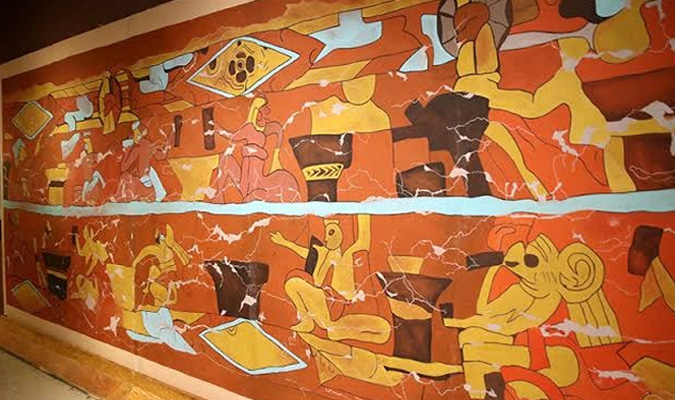
A mural in Cholula from 1000 CE, named “Los Bebedores” (The Drinkers), shows early evidence of pulque
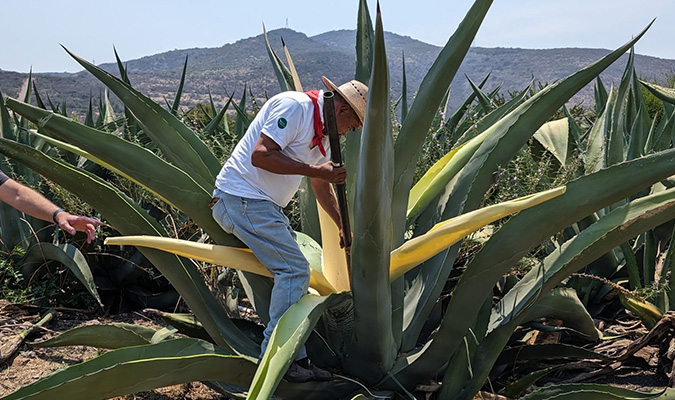
Journey Mexico Experience: Visit to a local family’s maguey fields outside of San Miguel Allende to learn about the history, harvesting, and production of aguamiel and pulque. Uncover how farms are utilizing maguey to help decrease CO2 emissions.
Henequin Agave, Green Gold
Agave was also the catalyst to a remarkable slice of history in southern Mexico, where the cultivation of hardy rope and twine from the fibers of the henequin (fourcroydes) variety go back to pre-Columbian Maya civilization. The 16th century Spanish invasion brought the construction of agricultural haciendas, which eventually expanded into henequin production from the mid-19th to mid-20th century. Planting, harvesting, and processing the agave fibers was labor-intensive, and the Maya, who had a long history of agriculture and skilled labor, were often employed as workers on these henequin hacienda plantations.
Mexico’s industrial revolution mechanized production and with growing international demand, henequin became such a lucrative business that the plant earned the moniker ´green gold´ – at one point there were over 1,000 working haciendas in the region. Due to the massive wealth generated from henequin, renamed sisal by the Spanish, the haciendas became symbols of affluence and the era saw the opulent homes and mansions of Mérida’s Paseo de Montejo being built by plantation owners. The boom came to a close as synthetic fibers were introduced and ultimately the industry collapsed, with the vast majority of haciendas left to ruin.
In recent decades, some of these incredible relics of time have been restored and transformed into luxury hotels, giving an economic boost to rural areas of the Yucatán and highlighting the area’s enduring Maya culture, another survivor of colonial subjugation. We love how Chablé Yucatán interlaces the guest experience with Maya heritage and wisdom, from its spa and wellness programs to traditional crop gardens and its Melipona Bee Sanctuary. One of our positive impact partners, Fundación Haciendas Mundo Maya, began as a project dedicated to restoring former henequin haciendas into a route of boutique hotels with the input and employment of residents. This amazing association has evolved to run development programs that preserve Maya culture whilst working towards eradicating poverty and the social marginalization of communities.
Pssst! If you want to step back in time, ask for Journey Mexico’s visit to the Yucatan´s only working henequin hacienda, complete with a beautiful, swimmable cenote within the grounds.
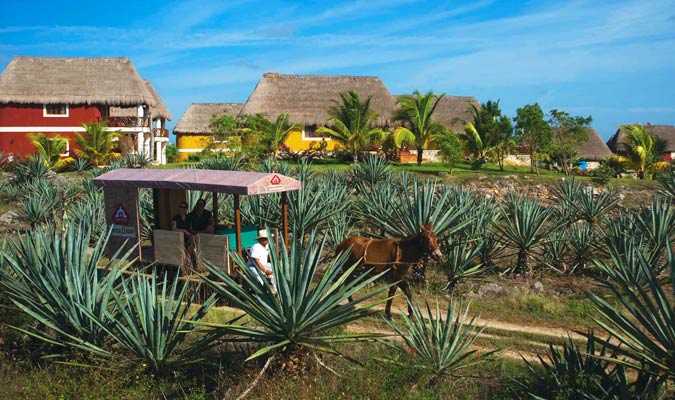
Mexico’s Agave Spirits Today
While some researchers have found signs of agave distillation in pre-Hispanic times, the method really took off when Spanish conquerors brought their own techniques to ´New Spain’ in the early 1500´s. All agave spirits are born from careful cultivation and processing practices that have been tested, refined, and passed down throughout generations. Once the core ´piña´ of the agave plant has been harvested by the ´jimadores´, it’s roasted, steamed or smoked, crushed to extract the juice that’s then fermented, and finally distilled, with each spirit carrying the unique qualities of its terroir.
TEQUILA
Plant: Blue Agave (tequilana weber)
Produced primarily in the state of Jalisco
As the Spanish moved through Mexico towards the north, so did the distillation process. Arriving to what is now the state of Jalisco, they encountered an indigenous community called the “Tiquili” from the village of Tequitlan, which the Spaniards later shortened to Tequila. Roughly translated as ´place of duty, honor, or hard work’ from its native Nahuatl, perhaps the values of craftmanship, dedication and devotion that would later cement family tequila legacies, were already written into the region’s story.
Tequila, like Champagne, is protected by an appellation of origin, meaning that the alcohol can only be made in Jalisco, and a handful of other states. Here, some 200,000 years ago, a volcano erupted, blessing the region with the rich volcanic soil that is ideal for growing blue agave (tequilana weber), the only variety that can be used to make Tequila. Once the piñas have been processed, the amount of time and in what type of barrel the tequila is distilled, like oak or stainless steel, define whether the finished spirit is Blanco, Reposado, Añejo, or Extra Añejo. We got our CEO, Founder, and tequila aficionado, Zach, to share some of his favorites:
“I like the crisp, ultra-refined texture of Casa Dragones Joven to start a meal. The stronger, unadulterated flavor and essence of Don Julio Blanco balanced with soda and lime on the rocks for the moderated pace of an extended night. And for a night cap, the woody, softer flavor/texture of Jose Cuervo Reserva de la Familia Extra Añejo, Don Julio Real Extra Añejo or better yet, Don Fulano Extra Añejo!”
Discover Tequila: Whether you’re tequila-curious or a seasoned fan, you’ll love our trip to the agave fields and distilleries of Tequila, an immersive journey for the senses that takes you to the heart of this long-standing ritual. For an intimate tequila session in San Miguel, we can book you a slot at the 6-seater Casa Dragones Tasting Room as the finale to a day exploring the city with a private guide.

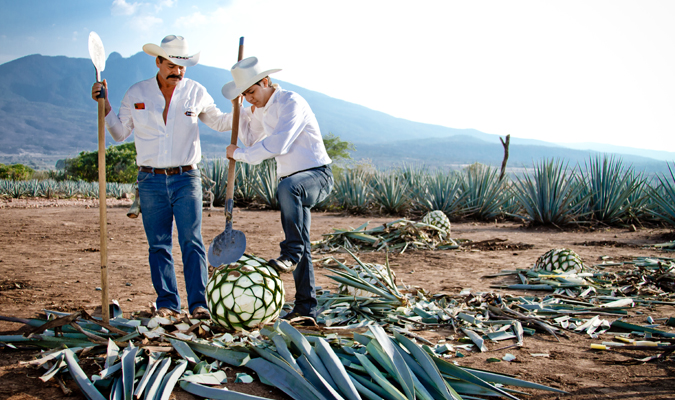
Journey Mexico Experience: Visit the home of tequila and witness its striking blue agave fields, recognized as a UNESCO World Heritage site. Learn about the processes and history and explore two distilleries with your own private Maestro Tequilero.
MEZCAL
Plant: Espadín (agave angustifolia), Arroqueño (agave americana), Mexicano (agave rhodacantha), Tepeztate (agave marmorata),Tobalá (agave potatorum), Cupreata (agave cupreata), among other varietes!
Produced primarily in the state of Oaxaca
Mezcal is widely thought to be the first distilled spirit made from the agave plant and it’s still the colloquial term for distilled agave spirits in Mexico today – while tequila falls under the umbrella of mezcal, not all mezcal is tequila. This magical distillate derives its name from the Nahuatl words “metl,” meaning agave plant, and “mexcalli” or “mexcallitl”, which translates as cooked agave. Mezcal can be made from around 30 varieties of the plant, most commonly Espadín, which allows more opportunity for variation than in tequila production. As the types of agaves used for mezcal can be grown in several different states they take on take on the terroir of the different microclimates where they grow, such as Guanajuato, Puebla and Michoacán. To achieve mezcal’s classic smokiness, the agave ´piñas´ are often roasted over hot stones in a pit oven below the earth.
Dive into Mezcal: Oaxaca is particularly renowned for its mezcal. Ask for our insider tasting experience in the historical center, with spirits sourced directly from the mezcalero families who have been producing it for generations, or we can whisk you away to a mountain town to meet an expert mezcal producer and see how it’s done firsthand. Thirsty in the capital? Check out our foodie trip that covers both Oaxaca and Mexico City. We’ll take you for tasty tacos and a nightcap with an expert at the city’s first mezcal bar, or to soak up the atmosphere of a traditional mezcalería before heading for a fun evening of Mexican wrestling at the Lucha Libre. Our trip to Milpa Alta on the outskirts of Mexico City blends sustainable farming and culinary heritage. Learn about ancient crops like nopal cactus and corn before finishing with a 4-course meal accompanied with a private mezcal tasting experience.
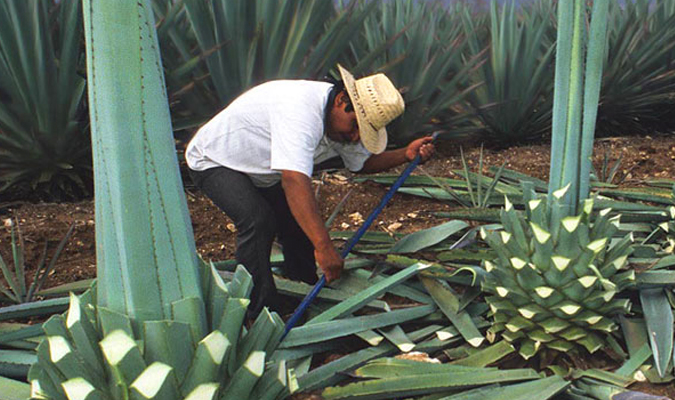
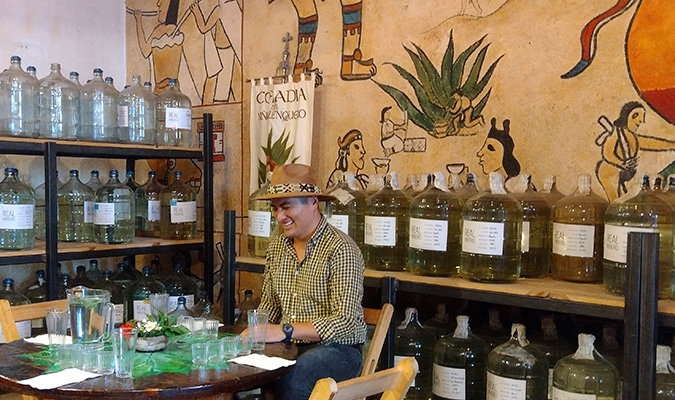
Journey Mexico Experience: Visit the heart of mezcal production deep in the Sierra Madre Mountains of Oaxaca where you can learn about (and taste!) one of the best quality mezcals in the world!
RAICILLA AND BACANORA
Plant: Raicilla – Lechuguilla (agave maximiliana), Maguey bruto/chico (agave inaequidens), amongst others / Bacanora – Maguey pacifica (agave angustifolia)
Produced: Jalisco coastal and mountain communities / Sonora desert
Variation in agave selection opens the door to a wide range of spirits that reflect local cultures and geographical conditions; some of our favorite lesser-known agave spirits include raicilla and bacanora. Raicilla’s more rustic, homemade methods reflect its historical roots in rural Jalisco communities, particularly along the coast near Puerto Vallarta. Raicilla can be made from several types of agave native to Jalisco like maximiliana and chico agar, with sweet, tropical and fruity notes. Bacanora is exclusively distilled from the wild agave pacifica, which only grows in the mountain ranges of the arid Sonoran Desert in northern Mexico, giving a dry, peppery and earthy flavor profile.
Next time you’re in Mexico City, let us take you to the leafy suburbs of Coyoacán to sip regional Mexican spirits like tequila, mezcal, bacanora and sotol, accompanied by a tasting menu of traditional flavors. Alternatively, roll up your sleeves for a cooking class designed by Mexican TV chef, Graciela Montaño, where you’ll savor your creations with a special selection of mezcals, sotol, and bacanora. Jalisco’s Pacific coast is the place to try raicilla! In the buzzing beach town of Sayulita, we’ll show you how to order raicilla, mezcal and tequila like a local, as well as deepening your knowledge of their origins and distillery processes.
What about Sotol?
Sotol is distilled in the northern states of Chihuahua, Durango, and Coahuila. While production methods share some similarities with agave spirits, sotol is made from the Desert Spoon (Dasylirion), which is a different type of plant to maguey.
Want to add an Agave Experience to your next Mexico Trip?
We have a collection of agave-related experiences across Mexico that you can insert into your personalized itinerary. Get in touch our expert travel planners and tell them about your interests to start creating your custom trip. Our bespoke journeys start from $1,000 USD per day for two travelers in interior Mexico, and $1,800 per day for two travelers in beach destinations.

